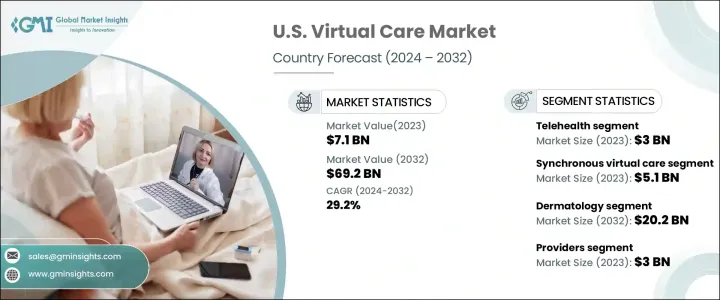PUBLISHER: Global Market Insights Inc. | PRODUCT CODE: 1716567

PUBLISHER: Global Market Insights Inc. | PRODUCT CODE: 1716567
U.S. Virtual Care Market Opportunity, Growth Drivers, Industry Trend Analysis, and Forecast 2024 - 2032
U.S. Virtual Care Market reached USD 7.1 billion in 2023 and is projected to grow at a CAGR of 29.2% from 2024 to 2032. This rapid expansion is fueled by the rising demand for digital health platforms and telecommunication technologies that facilitate remote healthcare consultations. Virtual care has emerged as a transformative force in the healthcare industry, bridging gaps between patients and providers, particularly in underserved areas where access to traditional medical facilities remains a challenge. The increasing adoption of virtual care solutions is largely driven by the growing prevalence of chronic diseases, including cardiovascular ailments, cancer, diabetes, and neurological disorders, all of which require continuous medical supervision.

The integration of artificial intelligence, wearable health tech, and advanced data analytics further enhances the efficacy of virtual care services, enabling seamless and personalized healthcare experiences. Additionally, regulatory support and financial incentives from the government are accelerating the expansion of digital health initiatives, encouraging broader adoption among both healthcare providers and patients. The evolving consumer preference for remote healthcare, coupled with technological advancements in telehealth and telemedicine, is expected to drive the market's long-term growth.
| Market Scope | |
|---|---|
| Start Year | 2023 |
| Forecast Year | 2024-2032 |
| Start Value | $7.1 Billion |
| Forecast Value | $69.2 Billion |
| CAGR | 29.2% |
The U.S. Virtual Care Market is segmented into various service types, including telemedicine, telehealth, and remote patient monitoring. The telehealth segment alone accounted for USD 3 billion in 2023, reflecting a significant share of the market. The government's rising investments in telehealth initiatives are further propelling growth, enabling individuals to access quality medical consultations from the comfort of their homes. With digital health solutions becoming more widely accepted, particularly in rural and underserved regions, the demand for virtual care services is surging. The expansion of insurance coverage for telehealth services is also playing a crucial role in market proliferation, making virtual healthcare more accessible and affordable for patients across diverse demographics.
Based on delivery mode, the U.S. Virtual Care Market is categorized into synchronous and asynchronous virtual care. The synchronous segment, valued at USD 5.1 billion in 2023, dominates the market due to its real-time interaction capabilities. This mode facilitates immediate consultations between healthcare providers and patients through video calls, phone interactions, and live chats, making it the preferred choice for urgent medical guidance, chronic disease management, and post-treatment follow-ups. The ability to replicate in-person consultations has positioned synchronous virtual care as an essential component of modern healthcare services, particularly as patients seek timely medical assistance without geographical constraints.
By end user, the U.S. Virtual Care Market is classified into payers, providers, and patients. The providers segment alone generated USD 3 billion in 2023, showcasing the growing reliance of hospitals and specialty clinics on virtual care solutions. Healthcare providers are increasingly integrating telemedicine and telehealth into their service offerings to enhance patient engagement, streamline operations, and alleviate the burden of in-person visits. The shift towards digital healthcare solutions is expected to continue as providers recognize the long-term benefits of virtual consultations, especially in managing chronic conditions and improving patient outcomes. The ongoing digital transformation in the healthcare sector, coupled with the increasing emphasis on patient-centric care, is anticipated to drive further market expansion in the coming years.
Table of Contents
Chapter 1 Methodology and Scope
- 1.1 Market scope and definitions
- 1.2 Research design
- 1.2.1 Research approach
- 1.2.2 Data collection methods
- 1.3 Base estimates and calculations
- 1.3.1 Base year calculation
- 1.3.2 Key trends for market estimation
- 1.4 Forecast model
- 1.5 Primary research and validation
- 1.5.1 Primary sources
- 1.5.2 Data mining sources
Chapter 2 Executive Summary
- 2.1 Industry 3600 synopsis
Chapter 3 Industry Insights
- 3.1 Industry ecosystem analysis
- 3.2 Industry impact forces
- 3.2.1 Growth drivers
- 3.2.1.1 Increasing incidence of chronic diseases
- 3.2.1.2 Advancements in healthcare IT technologies
- 3.2.1.3 Rising demand for remote healthcare solutions
- 3.2.1.4 Growing number of smartphone users
- 3.2.2 Industry pitfalls and challenges
- 3.2.2.1 Security concerns regarding patient data
- 3.2.2.2 Lack of awareness regarding virtual care
- 3.2.1 Growth drivers
- 3.3 Growth potential analysis
- 3.4 Regulatory landscape
- 3.5 Technological landscape
- 3.6 Future market trends
- 3.7 Porter's analysis
- 3.8 PESTEL analysis
Chapter 4 Competitive Landscape, 2023
- 4.1 Introduction
- 4.2 Company market share analysis
- 4.3 Company matrix analysis
- 4.4 Competitive analysis of major market players
- 4.5 Competitive positioning matrix
- 4.6 Strategy dashboard
Chapter 5 Market Estimates and Forecast, By Service Type, 2021 – 2032 ($ Mn)
- 5.1 Key trends
- 5.2 Telehealth
- 5.3 Telemedicine
- 5.4 Remote patient monitoring
Chapter 6 Market Estimates and Forecast, By Delivery Mode, 2021 – 2032 ($ Mn)
- 6.1 Key trends
- 6.2 Synchronous virtual care
- 6.3 Asynchronous virtual care
Chapter 7 Market Estimates and Forecast, By Application, 2021 – 2032 ($ Mn)
- 7.1 Key trends
- 7.2 Cardiology
- 7.3 Gynecology
- 7.4 Neurology
- 7.5 Orthopedics
- 7.6 Dermatology
- 7.7 Mental health
- 7.8 Other applications
Chapter 8 Market Estimates and Forecast, By End Use, 2021 – 2032 ($ Mn)
- 8.1 Key trends
- 8.2 Payers
- 8.3 Providers
- 8.4 Patients
- 8.5 Other end use
Chapter 9 Company Profiles
- 9.1 American Well Corporation
- 9.2 AMD Global Telemedicine
- 9.3 CareClix
- 9.4 CVS Health Corporation
- 9.5 Included Health
- 9.6 HealthTap
- 9.7 iCliniq
- 9.8 Koninklijke Philips N.V.
- 9.9 Oracle Corporation
- 9.10 Sesame
- 9.11 Siemens Healthineers
- 9.12 Teladoc Health
- 9.13 The Cigna Group
- 9.14 UnitedHealth Group
- 9.15 Virtuwell




